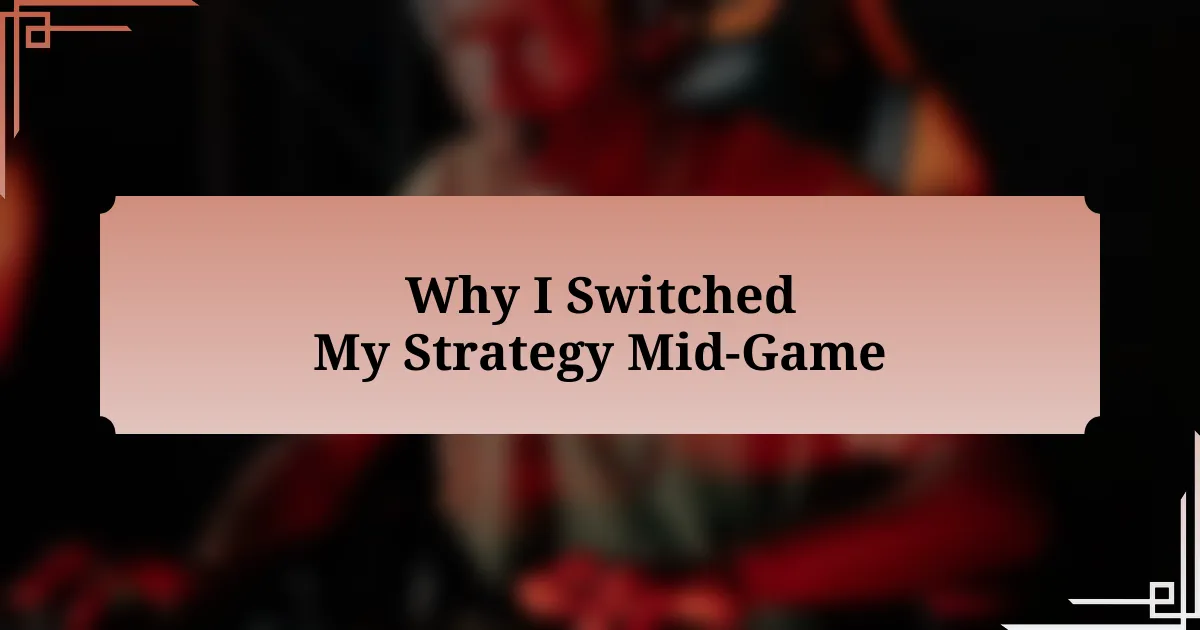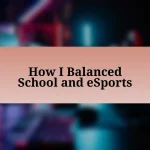Key takeaways:
- Adaptability in strategy is crucial in eSports, as matches can shift dynamics rapidly, requiring players to think on their feet and pivot effectively.
- Strong communication and collaboration within the team can significantly enhance gameplay and restore morale during challenging moments.
- Analyzing the situation critically can lead to better strategic decisions and a more stable emotional state, helping teams to regain control and momentum in matches.
- Implementing a step-by-step approach and leveraging individual strengths can transform team performance and foster a supportive atmosphere.
Author: Evelyn Hartley
Bio: Evelyn Hartley is an award-winning author known for her compelling narratives and richly drawn characters. With a background in psychology and literature, she weaves intricate tales that explore the complexities of human relationships and the intricacies of the human psyche. Her debut novel, “Whispers in the Dark,” was celebrated by critics and readers alike, earning her a dedicated following. Evelyn’s work has been featured in various literary journals and anthologies, and she frequently speaks at writing conferences and workshops. When she’s not writing, she enjoys hiking in the mountains and volunteering at her local animal shelter. She resides in Seattle with her two rescue dogs, Luna and Milo.
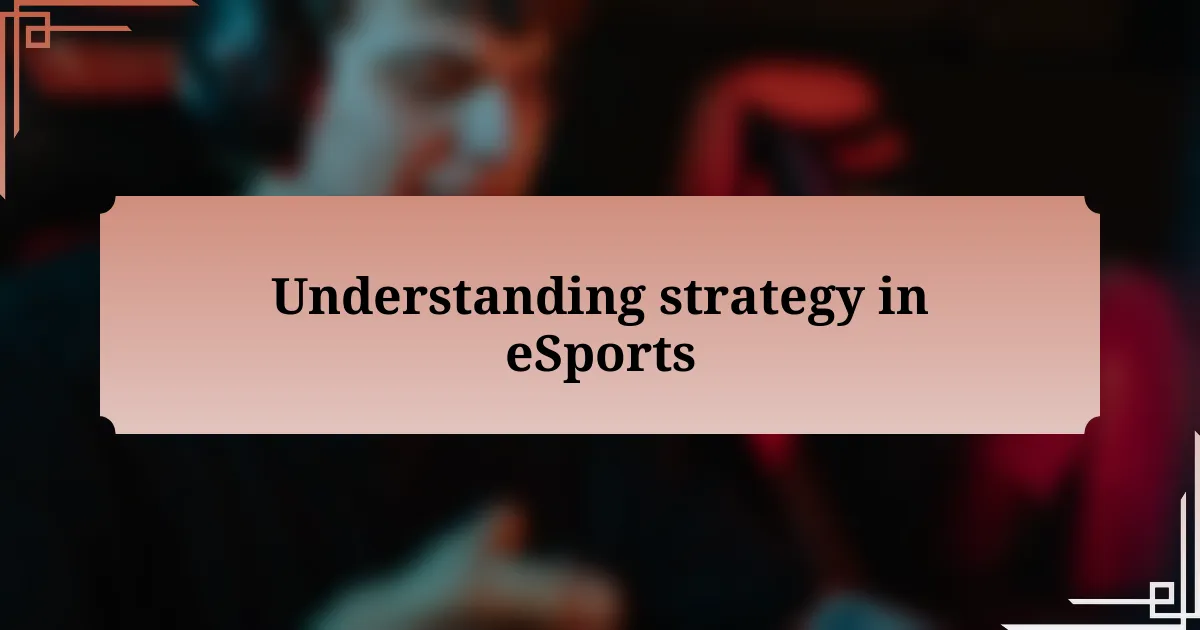
Understanding strategy in eSports
In eSports, strategy isn’t just about knowing the game mechanics; it’s about understanding your opponent’s mindset. I remember a particularly intense match where our team’s original plan crumbled under pressure. It made me realize how crucial it is to read the game as it unfolds, adapting rapidly to counter unexpected moves.
Every match offers a complexity that requires players to think on their feet. Have you ever experienced that moment when your initial plan feels stale? I recall a game where our team was forced to pivot after the enemy unexpectedly executed a perfect surprise attack. That moment taught me that flexibility in strategy can be the difference between victory and defeat.
Moreover, successful strategies are often built on strong communication within the team. When I played in a tournament, our coordination was our strongest asset. A split-second miscommunication can derail even the most well-thought-out strategies, leading me to appreciate the synergy required to adapt effectively mid-game.
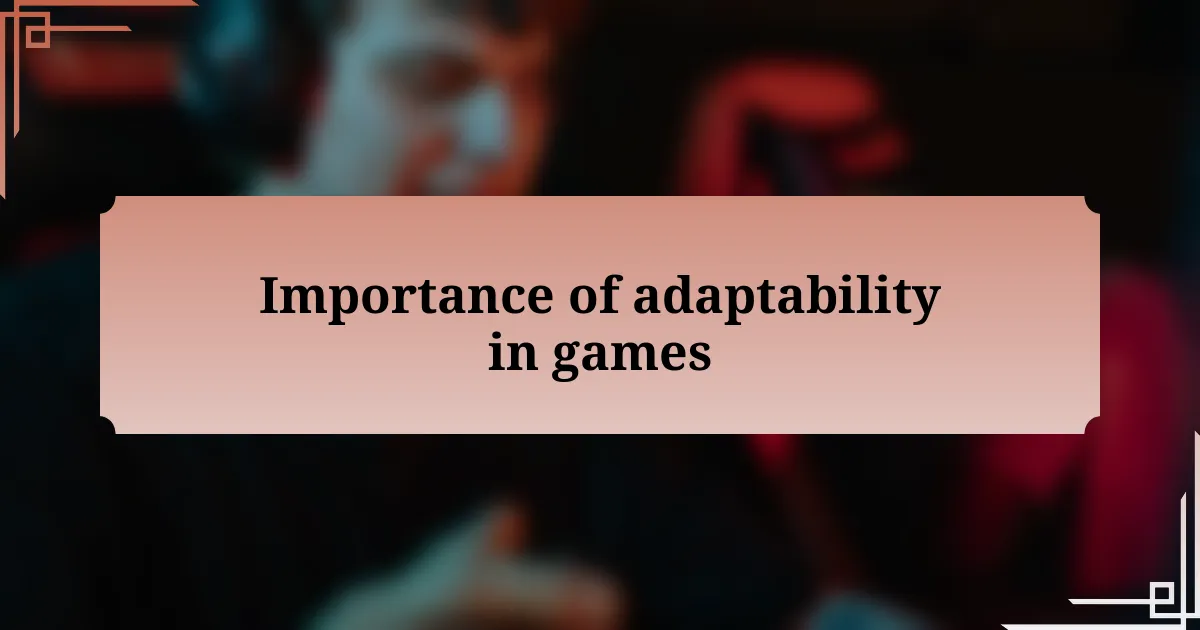
Importance of adaptability in games
Adaptability in gaming is vital because the landscape can change in an instant. I remember a match where our team thought we had a solid plan, but then our opponents executed a tactic we hadn’t anticipated. In that moment of confusion, the ability to pivot and adjust our strategy was what ultimately kept us in the game.
It’s fascinating how quickly the dynamics of a match can shift. I once played a round where we were leading, and then suddenly, everything went south. The enemy team caught us off guard with a sneaky strategy, forcing us to rethink our approach completely. That experience taught me that the most prepared player isn’t always the one who wins; it’s often the one who can adapt and embrace change swiftly.
Adapting doesn’t just involve adjusting tactics; it’s about mindset. I find that being flexible opens the door to creative solutions, like the time we made an unexpected rush play that won us the game. Have you faced a scenario where going off-script led to an unexpected win? It really illustrates how essential flexibility is in eSports, as it can turn the tide in one’s favor when the pressure is on.
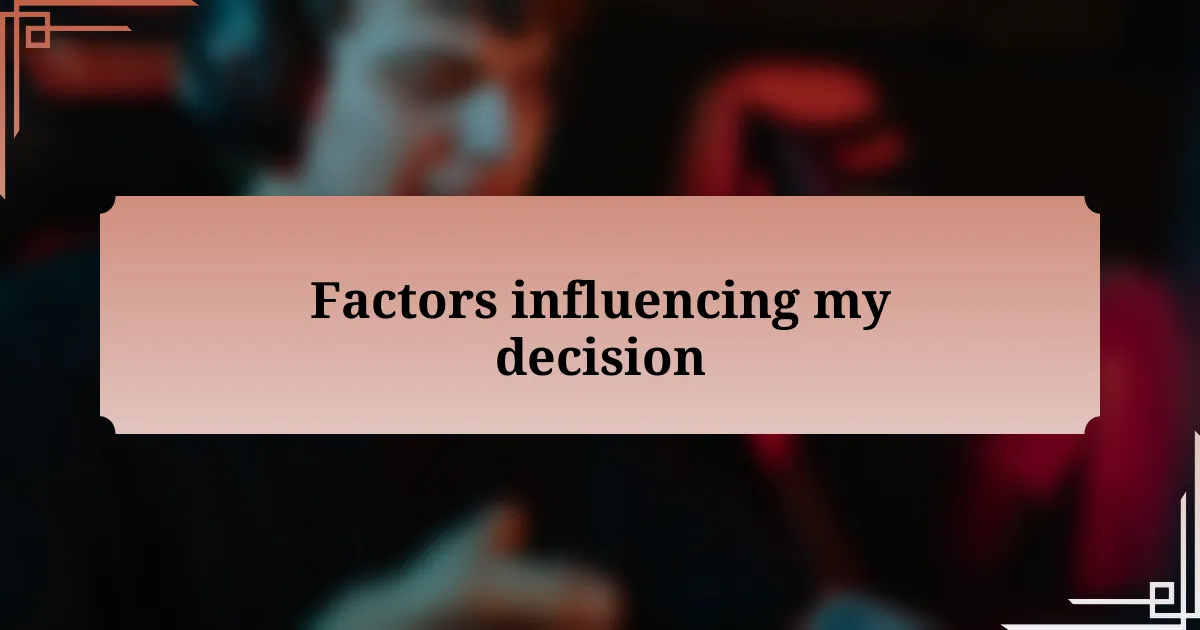
Factors influencing my decision
Sometimes, the decision to switch my strategy mid-game is influenced by the energy and morale of my team. I recall a moment when our communication broke down, and it felt like everyone was losing steam. Sensing the shift in attitudes, I decided to implement a strategy that focused more on collaboration and support, which ultimately reignited our team spirit and turned the match around.
Another key factor is the opposing team’s moves. In one tournament, I noticed that they heavily relied on a specific character combo, and it became clear that sticking to our original plan would likely lead to our downfall. I quickly adapted by changing my character to counter their strategy, which not only disrupted their flow but also gave my team the advantage we desperately needed. Have you ever had to pivot based on your opponent’s choices? It’s amazing how closely observing your rivals can guide your decisions.
Lastly, my own emotional state often guides my strategic shifts. I remember a match where I started to feel frustrated and anxious after a few setbacks. Realizing that those emotions were clouding my judgment, I switched to a more defensive playstyle, giving myself time to regain focus and clarity. This shift not only helped me regain my composure but allowed me to play more effectively as we took back the momentum. How do you harness your emotions in-game? It’s a delicate balance, but acknowledging them can lead to stronger gameplay.
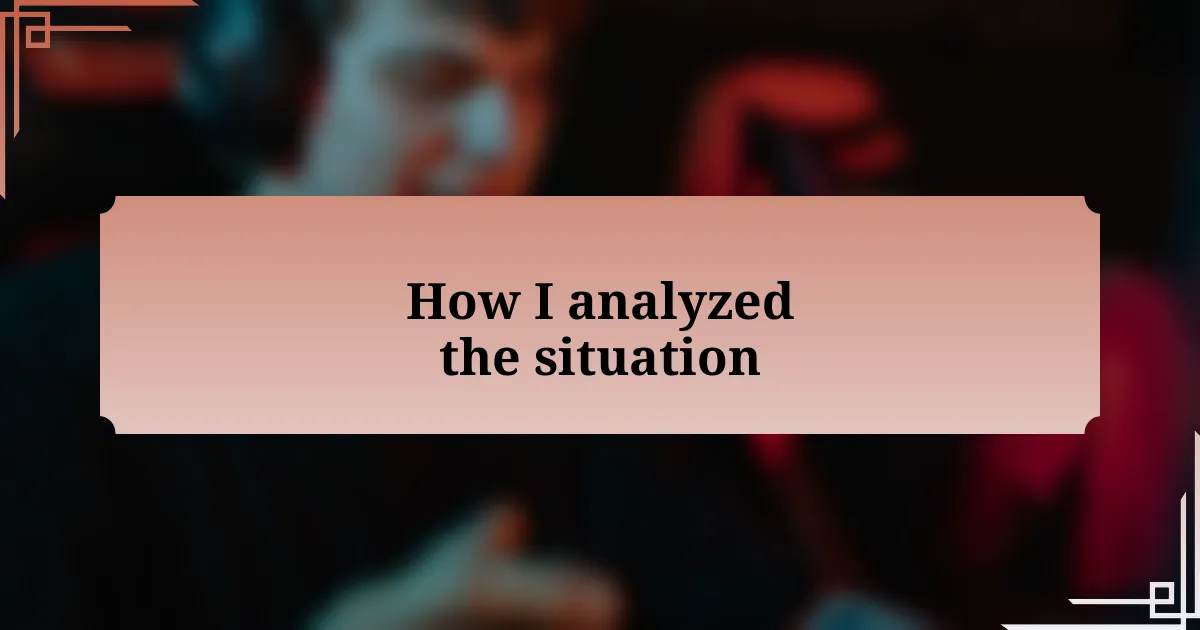
How I analyzed the situation
Taking a step back to evaluate the situation during a match has often led me to important realizations. For instance, there was a game where our team was clearly outmaneuvered at the start. Instead of sticking stubbornly to our initial strategy, I asked myself what was working and what wasn’t. I noticed that our defense was weak against their flanking tactics, which prompted me to call for tighter formations and increased vigilance, allowing us to regain control.
One specific moment sticks out in my mind when I was assessing not just our performance but also how the game dynamics had shifted. The enemy team had become overly aggressive, and many of my teammates were visibly rattled. I thought, “What can we do to turn this tide?” By analyzing their patterns, I suggested a shift to baiting their aggressive moves, drawing them into traps we could exploit. This calculated shift not only restored our confidence but also put the pressure back on them.
My emotional awareness has played a significant role in my analysis, too. I recall feeling the weight of expectations during a critical match—my heart was racing, and my thoughts were scattered. It was then that I realized that I needed to simplify our strategy. I proposed we fall back to a more straightforward playstyle focused solely on communication and teamwork. It felt grounding and allowed us to focus on the fundamentals, which ultimately led to us mounting a comeback. Have you ever found clarity by simplifying your approach in-tournament? It can be incredibly liberating.
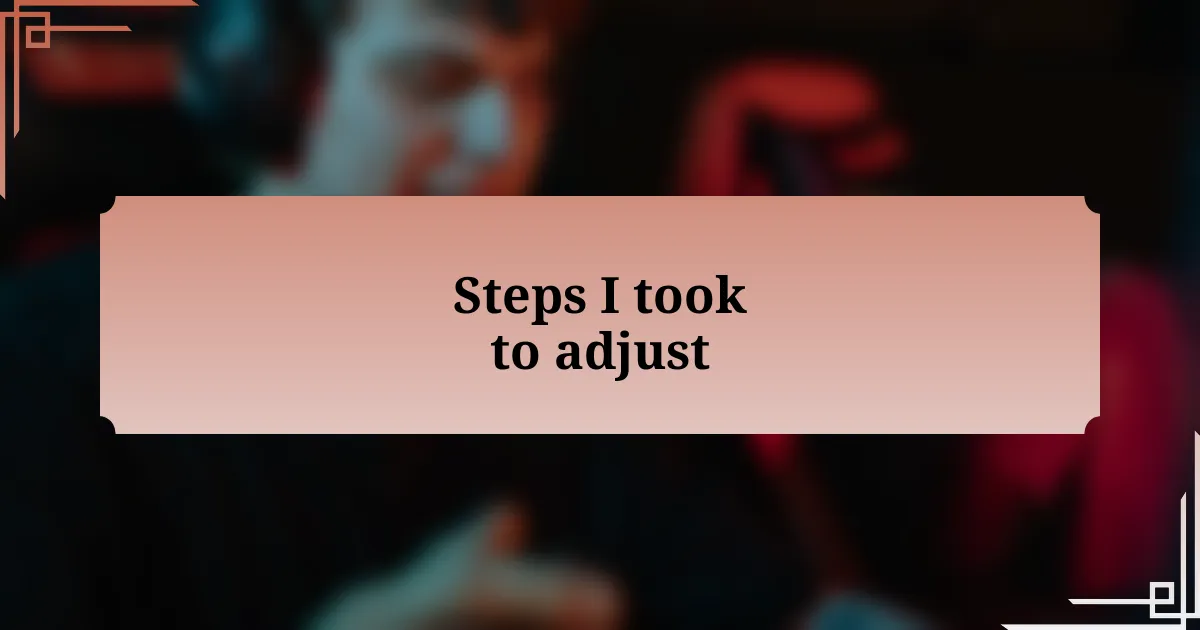
Steps I took to adjust
When it became clear that our original tactics weren’t working, I took a moment to recalibrate. I reached out to my teammates for their thoughts, creating a safe space for open dialogue. During this discussion, one teammate highlighted how their character had a strong counter to our opponents’ aggression, which led me to adjust our focus on leveraging that character’s strengths. This collaborative approach not only lightened the mood but also encouraged everyone to contribute.
Next, I vividly remember the moment we decided to incorporate more mobility into our gameplay. I felt a surge of excitement as we rehearsed new maneuvering tactics, consciously moving away from the overly static formations we had settled into. As we practiced, I noticed my confidence building, and I could see that my teammates were energized too. Have you ever experienced that electric moment when a strategy starts to materialize? It’s a feeling that reinvigorates you in the heat of battle.
Lastly, in the heat of the game, I emphasized the “one step at a time” philosophy. I suggested that we take it slow, focusing on securing one objective at a time instead of trying to win the whole match in one go. This approach calmed my nerves and helped prevent any form of panic. It felt like a breath of fresh air, reinforcing our commitment to winning incrementally rather than getting caught up in the chaos. It’s remarkable how recalibrating your focus can completely change the trajectory of a game.
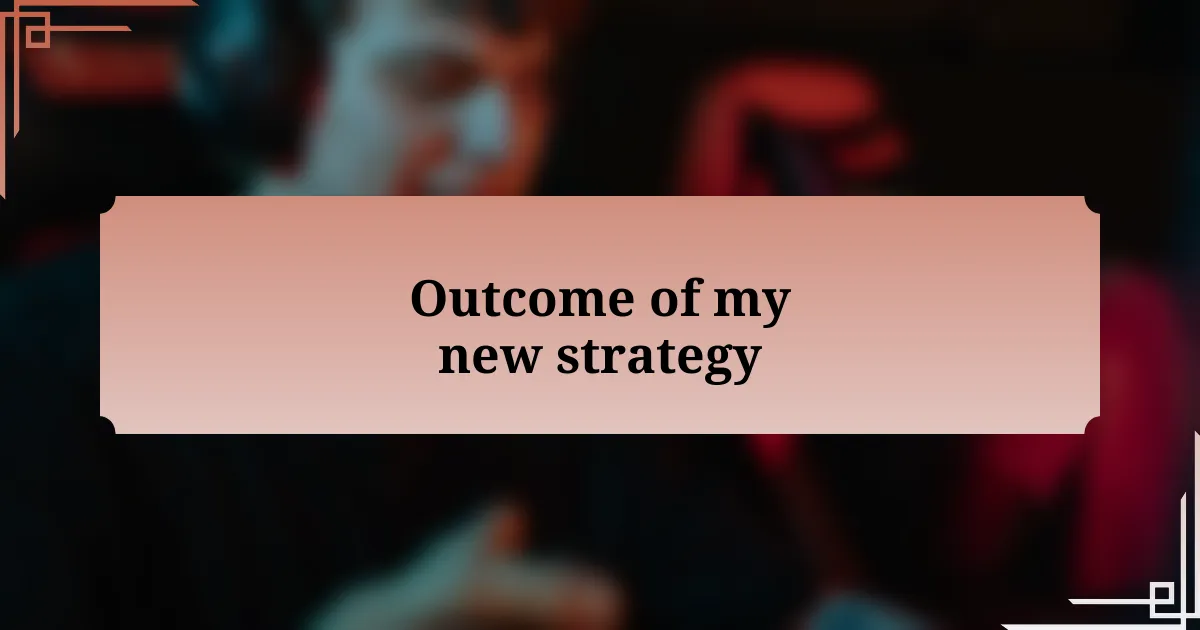
Outcome of my new strategy
The outcome of my new strategy was transformative, and I could feel the shift almost immediately. As we executed the revised game plan, I watched my teammates embrace their roles with newfound energy. We outmaneuvered the opposition, and with each successful objective, my confidence soared. It felt like we were finally in sync, as if a long-lost rhythm had returned to our gameplay.
One moment that stands out vividly was when we took the lead during a critical engagement. I can still recall the adrenaline rush when we successfully executed a flanking maneuver that caught our opponents off-guard. The exhilaration of that unexpected victory fueled our momentum, propelling us to continue pressing our advantage. Have you ever felt that rush when everything clicks? It’s a rush that ignites the team spirit in ways nothing else can.
Overall, the results were beyond what I had anticipated. Not only did our team performance improve, but our communication flourished as well. By focusing on our strengths rather than our weaknesses, we created an atmosphere of support and trust. It was in those moments of collaboration that I realized how pivotal it is to adapt and embrace change in eSports. The right strategy can make all the difference, turning a challenging situation into an exhilarating win.

